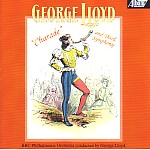George Lloyd wrote his first three symphonies at age 19, an astonishing achievement considering their quality. Like Shostakovich’s First, written at roughly the same age, the music reveals Lloyd in command of a distinctive personal voice, composed of frankly romantic melody, contemporary harmony (with perhaps a touch of jazz to spice things up), and brilliant orchestration. In this last department, particularly, Lloyd had a real gift, and like most orchestral “naturals” it reveals itself in his characterful treatment of the winds, and in his ability to play the various sections of the orchestra off against each other. Witness, for example, the brilliant brass fanfares at the start of the finale.
The symphony has three movements that run continuously, and lasts only about 23 minutes, or about the same time as Sibelius’ Seventh. Once again, for such a youthful work, it’s remarkably well-proportioned, and the quick outer movements have great fire and energy. Lloyd supposedly wished to suppress his three early symphonies, but decided against it because he didn’t want to re-number all the later ones; one hopes it was also because he quickly realized how characteristic of him they were, even if his later work naturally shows greater range and sophistication.
If the symphony’s Sturm and Drang first movement speaks of serious matters, the six-movement Charade Suite does just the opposite. The music offers a delightfully witty, tongue-in-cheek send-up of the 1960s, with titles that say it all: Student Power; L.S.D., March-In, Flying Saucers, Pop Song, and Party Politics. There’s great fun here. L.S.D is predictably languorous and hallucinogenic, while Flying Saucers is a wacky scherzo. Like all of Lloyd’s music, the orchestration is extremely colorful, but the musical content is also quite substantial despite its light-hearted character. Why this piece doesn’t appear regularly on the programs of “pops” concerts remains a mystery.
The performances of both pieces under the composer’s baton are quite fine, as you might expect. Lloyd was, among other things, a very good conductor. The BBC responds to this well-crafted music with enthusiasm: the brass especially do the finale of the symphony proud, while the sonics, if perhaps not ideally clear, and a touch studio-bound, are still very good. If you missed this disc on its first release, and find yourself enjoying Lloyd’s work generally, don’t hesitate.
































